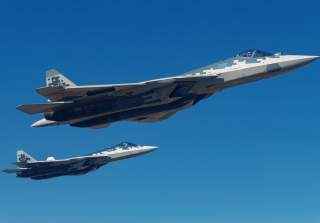How Russia's Su-57 Stealth Fighter Plans to Fight the U.S. Navy
Is that possible?
Key point: Russia's Su-57 is a stealth fighter similar to the F-22 and therefore is Moscow's best plane to equip with new anti-ship missiles.
Russia is designing an anti-ship missile for its Su-57 stealth fighter.
But is hunting ships the best mission for such an advanced aircraft?
Deputy Defense Minister Alexey Krivoruchko made the announcement while visiting the Detal Design Bureau, which is developing a new anti-ship missile, according to Russian news agency TASS.
“Today the enterprise is working on developing an active homing warhead for the promising anti-ship missile that is planned to be carried by the Su-57 fighter as well," Krivoruchko said.
“A working meeting was held on the premises of the Detal Design Bureau to discuss the issue of signing a contract with Tactical Missiles Corporation on acquiring the entire range of air-launched weapons for the Su-57 fighter jets,” TASS said.
The Su-57 is Russia’s equivalent of the U.S. F-22 and F-35 stealth fighters. A Mach 2 aircraft capable of air superiority and ground-strike missions, it is Russia’s first stealth plane, and probably the most sophisticated aircraft in the Russian arsenal. It also has a long and troubled history stretching back more than a decade, due to technical issues and even more because of financial considerations. Estimates have ranged from $40 million to $156 million per plane—a figure that earlier made the Russian Air Force cancel mass production and buy just a handful of aircraft. Russia now has about a dozen Su-57s, which have flown a few missions over Syria.
But last month, Russian president Vladimir Putin announced that seventy-six Su-57s would be delivered by 2028. Though Russian defense plans previously called for buying just sixteen aircraft, Putin said Defense Minister Sergei Shoigu had told him that the Su-57’s manufacturer had cut the price of the plane by 20 percent, which was a deal that the government couldn’t pass up. "We have agreed to purchase 76 such fighters without the increase in prices in the same period of time," Putin said.
Nonetheless, whether it is sixteen or seventy-six jets, that’s not a huge fleet. America has just 186 F-22 fighters, a number that many consider too small for sustained combat operations. The U.S. military also plans to acquire more than 2,400 F-35s.
Of course, Russia may choose to buy more than seventy-six Su-57s, depending on the country’s strained economy, and how well the aircraft performs once in regular service. But the size of the initial order suggests that the Russian Air Force could end up with just seventy-six aircraft—assuming that figure isn’t cut in future budgets over the next decade—and perhaps no more than a couple of hundred aircraft.
In which case, what is the best use of a cutting-edge stealth fighter? The capabilities of such a plane would be needed against an opponent possessing sophisticated aircraft and air defenses: America, NATO, Japan, Israel (or conceivably even China). To intercept hostile stealth aircraft, Russia will be tempted to send up its own stealth fighters. A fleet of just seventy-six Su-57s, minus the inevitable losses from combat, accidents and required maintenance, might be severely taxed by air defense and escort missions.
So how many would be left for anti-ship work? Against most naval targets, older planes such as Su-30 fighter and Tu-22M3 bomber—armed with hypersonic missiles would suffice. There may be situations where stealth is desired, perhaps against a heavily defended U.S. carrier battlegroup. But employing a limited number of Su-57s to attack ships is similar to assigning F-22s on anti-shipping missions—a move that would leave U.S. Air Force commanders aghast.
Michael Peck is a contributing writer for the National Interest. He can be found on Twitter and Facebook.
Image: Reddit. (This article was originally published earlier in June 2019 and is being republished due to reader interest.)

